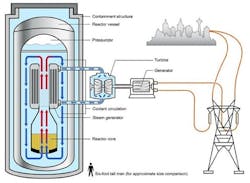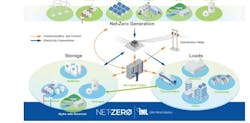INL report: Small Reactor Nuclear offers Fuel-secure, Carbon-free option for Microgrids
Using nuclear energy to power microgrids may sound out of reach, but on closer inspection it may make nearly perfect sense both environmentally and even financially over time, advocates say.
A new report written by energy consultant the Idaho National Laboratory follows on an earlier study exploring the potential of small modular reactor (SMR) nuclear for carbon-free microgrids which could provide power resiliency to mission critical services such as data centers, remote communities and military bases.
The INL-XENDEE report compares the potential of small nuclear in net-zero microgrids with models of natural gas-fired generation and renewables such as solar, wind and energy storage. There are currently no real operating SMR power plants, although the U.S. Nuclear Regulatory Commission recently gave approval to NuScale Power’s SMR design. Canadian power generators also are working on developing future SMR projects.
Yes, gas-fired and renewable-powered microgrids may be somewhat cheaper to build upfront, but the long-term gain with nuclear could pay off in terms of both resiliency and sustainability, the report reads. Some safety concerns are with nuclear are acknowledged, although the NRC finding noted safety improvement and redundancies with SMRs due to its compact design.
“The microgrid developed with NGGs (naturgal gas generators), although able to ride-through extended electrical grid outages, still require a continuous supply of natural gas,” the INL report reads. “In extended extreme weather or cyber-related outages, the natural-gas pipeline/supply chain can get disrupted. On the other hand, SRs can sustain such extreme outages due to long-lasting fuel. The fuel once loaded can last for multiple years (at least 2 years) without needing refueling.”
Thus, it noted, natural gas is not an on-site fuel resource but is delivered typically via pipelines which can be supply constricted under extreme circumstances. Nuclear energy has on-site supply, constant dispatchability and resiliency.
Renewables such as solar energy are carbon-neutral, but the capacity factor and resiliency are low, since the sun doesn’t always shine and photovoltaic energy outputs far less energy than it takes in. Nuclear has a higher capacity factor and can constantly run and does not emit greenhouse gases, reports note.
One of the models used in the INL report indicated that small nuclear could be economically competitive long-term compared to other dispatchable resources (such as gas) even without a future tax on carbon emissions.
“The optimization already results in negative CO2 emission even without considering a CO2 tax,” the report reads. “Adding a CO2 tax makes the financial case of SR even more attractive. The load-served LCOE (levelized cost of energy) is obtained as 0.1092 $/kWh.”
Same as gas-fired generator plants, small nuclear could offer cogeneration capabilities important to industrial and district heating customers.
“SRs can be operated in combined heat and power (CHP) mode to supply both heat and electricity,” it reads. “This could be done in two different ways: either by extracting process steam or by using the unused heat from the turbine exhaust. The process steam is extracted when high-quality heat is needed (e.g., high-temperature electrolysis). For low-temperature heat applications, such as district heating, the heat available at turbine exhaust can be used.”
Here’s more on the Reilly-XENDEE-INL report.
In October 2021, Idaho National Laboratory announced it is launching a new Net-Zero Microgrid program thanks to funding from the Department of Energy’s Office of Electricity. This program will research carbon-free solutions that offer enhanced resilience to critical infrastructure, supporting the U.S. and the entire globe, including underserved communities.
In the November report, it focused on the potential for SMR nuclear in a Net-Zero Microgrid scenario partly in remote communities. Those types of villages suffer from extreme weather and often have spotty electric transmission and distribution service.
And for remote industrial applications needing eliable combined heat and power (CHP or cogeneration) services but desiring to improve their sustainability profile, the INL report offers small reactors as a potential solution for those plants.
“Most remote communities lack clean resources to fulfill their heating needs,” it reads. Small reactors “can offer cogeneration to fulfill both heat and electricity demands of remote communities. This cogenerating configuration can boost the economic performance of the system while also offering means to flexible operation.”
Energy consultant Jim Reilly developed the SMR report in tandem with INL staff.
-- -- --
(Rod Walton, senior editor for EnergyTech, is a 14-year veteran of covering the energy industry both as a newspaper and trade journalist. He can be reached at [email protected]).
About the Author
Rod Walton, EnergyTech Managing Editor
Managing Editor
For EnergyTech editorial inquiries, please contact Managing Editor Rod Walton at [email protected].
Rod Walton has spent 17 years covering the energy industry as a newspaper and trade journalist. He formerly was energy writer and business editor at the Tulsa World. Later, he spent six years covering the electricity power sector for Pennwell and Clarion Events. He joined Endeavor and EnergyTech in November 2021.
Walton earned his Bachelors degree in journalism from the University of Oklahoma. His career stops include the Moore American, Bartlesville Examiner-Enterprise, Wagoner Tribune and Tulsa World.
EnergyTech is focused on the mission critical and large-scale energy users and their sustainability and resiliency goals. These include the commercial and industrial sectors, as well as the military, universities, data centers and microgrids. The C&I sectors together account for close to 30 percent of greenhouse gas emissions in the U.S.
He was named Managing Editor for Microgrid Knowledge and EnergyTech starting July 1, 2023
Many large-scale energy users such as Fortune 500 companies, and mission-critical users such as military bases, universities, healthcare facilities, public safety and data centers, shifting their energy priorities to reach net-zero carbon goals within the coming decades. These include plans for renewable energy power purchase agreements, but also on-site resiliency projects such as microgrids, combined heat and power, rooftop solar, energy storage, digitalization and building efficiency upgrades.


